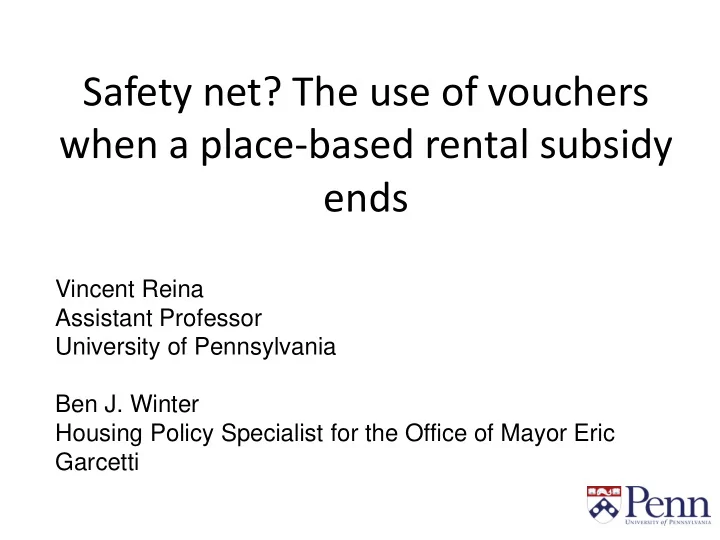

Safety net? The use of vouchers when a place-based rental subsidy ends Vincent Reina Assistant Professor University of Pennsylvania Ben J. Winter Housing Policy Specialist for the Office of Mayor Eric Garcetti
Overview of the project-based Section 8 program • Created under the Housing and Community Development Act of 1974 • Subsidized private owners • Over 1.2 million units were developed • Over 115,000 households lived in properties that exited the stock prior to 2011 • Vouchers are offered as a tenant protection when the subsidy ends
Motivation: the affordability problem The share of affordable private-market rental units has • decreased, and rent burdens have increased (Schwartz et al. 2016; Joint Center for Housing Studies 2017) There is increased demand for subsidized housing, • while the number of properties where owners will be eligible to end their existing subsidy contracts will increase going forward (Reina 2018) We know little about what happens to households who • live in these properties 3
Research questions 1. How many households use their voucher? 2. Do households who use their voucher move? 3. Do households who use the voucher move to lower poverty neighborhoods? 4. Do these outcomes vary based on household demand, market supply, or household demographic factors?
Existing literature: subsidy expirations
Existing literature: voucher use
Existing literature: voucher moves
Data • Constructed a national tenant-level database with proprietary HUD data from 1996-2010 • Combined the HUD data with American Community Survey data
Models •Dependent variables: o Odds of using a voucher o Odds of moving o Tract-level poverty rate •Independent variables: o Household demand o Market supply o Household demographics
Results: How many households use their voucher?
Results: Do households who use a voucher move?
Results: Do voucher households move to lower poverty neighborhoods? • The average poverty rate of a tract where a household lived when the contract ended was 26.8 percent • On the whole households moved to lower poverty neighborhoods • Controlling for moves, Black and Hispanic households were still associated with living in higher poverty tracts, while those with dependents were associated with living in slightly lower poverty tracts
Results: Summary
Limitations We lose our counterfactual • o What happens to those households who do not use their voucher? Other outcomes of interest • o Education outcomes o Health impacts
Policy recommendations • Invest in data to better understand which properties are at risk of losing subsidies • Develop networks that will: o Use these data o Ensure HUD regulations and fair housing laws are being followed • Incorporate all the potential losses in calculating the amount of subsidy offered to preserve existing affordable units • Account for demand, supply, and demographic factors when administering vouchers
Contact Information: Vincent Reina vreina@upenn.edu 16
Recommend
More recommend